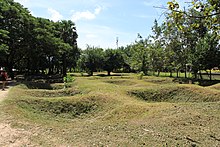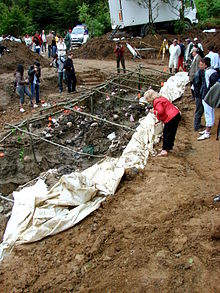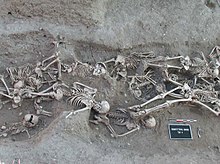
Burial, also known as interment or inhumation, is a method of final disposition whereby a dead body is placed into the ground, sometimes with objects. This is usually accomplished by excavating a pit or trench, placing the deceased and objects in it, and covering it over. A funeral is a ceremony that accompanies the final disposition. Evidence suggests that some archaic and early modern humans buried their dead. Burial is often seen as indicating respect for the dead. It has been used to prevent the odor of decay, to give family members closure and prevent them from witnessing the decomposition of their loved ones, and in many cultures it has been seen as a necessary step for the deceased to enter the afterlife or to give back to the cycle of life.

The Gardelegen massacre was a massacre perpetrated by the locals of the northern German town of Gardelegen, with direction from the SS, near the end of World War II. On April 13, 1945, on the Isenschnibbe estate near the town, the troops forced over 1,000 slave laborers who were part of a transport train evacuated from the Mittelbau-Dora and Hannover-Stöcken concentration camps into a large barn, which was then set on fire.

In Chechnya, mass graves containing hundreds of corpses have been uncovered since the beginning of the Chechen wars in 1994. As of June 2008, there were 57 registered locations of mass graves in Chechnya. According to Amnesty International, thousands may be buried in unmarked graves including up to 5,000 civilians who disappeared since the beginning of the Second Chechen War in 1999. In 2008, the largest mass grave found to date was uncovered in Grozny, containing some 800 bodies from the First Chechen War in 1995. Russia's general policy to the Chechen mass graves is to not exhume them.
The Korićani Cliffs massacre was the mass murder of more than 200 Bosniak and Croat men on 21 August 1992, during the Bosnian War, at the Korićani Cliffs on Mount Vlašić in central Bosnia and Herzegovina.

Mass graves in Iraq have become well known since the 2003 invasion of Iraq toppled the regime of Saddam Hussein. International Experts estimated that 300,000 victims could be in these mass graves alone. The mass graves mostly included the remains of Shia Muslims and ethnic Kurds, who were killed for opposing the regime between 1983 and 1991.

The Vinnytsia massacre was the mass execution of between 9,000 and 11,000 people in the Ukrainian town of Vinnytsia by the Soviet secret police NKVD during the Great Purge in 1937–1938, which Nazi Germany discovered during its occupation of Ukraine in 1943. The investigation of the site first conducted by the international Katyn Commission coincided with the discovery of a similar mass murder site of Polish prisoners of war in Katyn. Among the 679 dead identified by the Germans in 1943, there were also a certain number of Russians and 28 Poles. Nazi propaganda invoked mention of the massacre to illustrate communist terror by the Soviet Union.
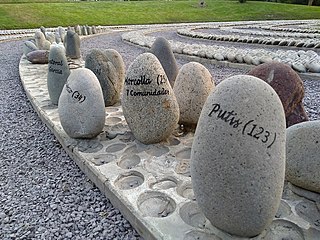
The Putis Massacre was a massacre of 123 campesinos carried out by the Peruvian Army in a rural hamlet in the Santillana District of the Huanta Province in the Ayacucho Region of Peru. The massacre occurred in December 1984.
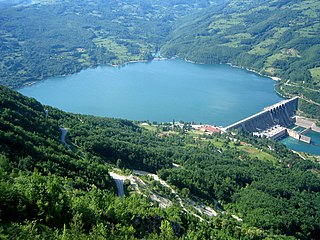
Lake Perućac is an artificial lake on the Drina River, on the border between Bosnia and Herzegovina and Serbia. It was created in 1966 and occupies a natural bend of the river, which encircles the Tara mountain, between towns of Višegrad in Bosnia and Bajina Bašta in Serbia.
The Tatarka common graves were mass graves discovered in April–August 1943, during World War II, by Axis-allied Romanian troops occupying Transnistria, on a lot of 1,000 m2 (11,000 sq ft) in Tatarka, now Prylymanske, in Odesa Raion, near Odesa. Some 42 separate common graves of several dozen bodies each were identified, containing between 3,500 and 5,000 bodies, of which 516 were exhumed, studied, and buried in a cemetery before the region became a front line. The commission set up by the Romanian authorities to investigate these graves reported that among the dead were persons arrested in the Moldavian ASSR in 1938–1940 and in Bessarabia and northern Bukovina in 1940–1941.
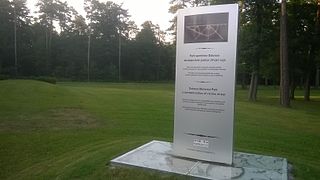
The Tezno massacre was the mass killing of POWs and civilians of the Independent State of Croatia (NDH) that took place in Tezno near Maribor after the end of World War II in Yugoslavia. The killings were perpetrated by units of the Yugoslav Partisans in May 1945, in the Bleiburg repatriations. Summary executions began on 19 May, when the first prisoners arrived in the Tezno Forest from nearby prison camps, and they continued until 26 May. Most of the bodies were buried in an antitank trench several kilometers long, which the Yugoslav authorities concealed and kept secret.
The Batajnica mass graves are mass graves that were found in 2001 near Batajnica, a suburb of Belgrade, the capital of Serbia. The graves contained the bodies of 744 Kosovar Albanians civilians that were killed during the Kosovo War. The mass graves were found on the training grounds of the Yugoslav Special Anti-Terrorist Unit (SAJ). Dead bodies were brought to the site by trucks from Kosovo; most were incinerated before burial. After the war, SAJ restricted investigators' access to the firing range, and continued live-firing exercises whilst forensic teams tried to investigate the massacre.

The Snagovo massacre refers to the mass killing of 36 Bosnian Muslim civilians by Serbs on 29 April 1992 in the village Snagovo, located in the municipality of Zvornik, Bosnia and Herzegovina. The massacre occurred at the start of the Bosnian War.

The Arnsberg Forest massacre was a series of mass extrajudicial killings of 208 forced labourers and POWs (Ostarbeiter), mainly of Russian and Polish descent, by Nazi troops under the command of Hans Kammler from 20 to 23 March 1945.
The Ugljare mass grave is a burial site in the village of Ugljare in the Kosovo municipality of Gjilan. Those buried include Kosovo Serbs and possibly Kosovo Albanians sometime around July 1999. At the time, it was the only case which involved in the Kosovo war crimes tribunal the investigation of a crime against civilians which was possibly committed by Albanians against Serbs. No perpetrators have been found. Kosovo leaders during the war, including former Prime Minister and the "George Washington of Kosovo", Hashim Thaci, are currently on trial for crimes against humanity, murder, forced deportation, kidnapping, and persecution of Serbs and other minorities in a specially commissioned court, The Kosovo Specialist Chambers, established to prosecute Albanian leaders for crimes during and after the Kosovo War.

Since the beginning of the Russian invasion of Ukraine in 2022, the Russian military and authorities have committed war crimes, such as deliberate attacks against civilian targets ; indiscriminate attacks on densely-populated areas ; abduction, torture and murder of civilians; forced deportations; sexual violence ; destruction of cultural heritage; and mistreatment, torture, mutilation and murder of Ukrainian prisoners of war.

The battle of Izium was a military engagement between Russia and Ukraine that occurred as part of the eastern Ukraine offensive during the Russian invasion of Ukraine. The battle started in March 2022 for control of the town of Izium due to the town's importance as a transportation node. The Russian military wanted to capture Izium so its forces in Kharkiv Oblast could link up with their troops in the Donbas region.

The Bucha massacre was the mass murder of Ukrainian civilians and prisoners of war by the Russian Armed Forces during the fight for and occupation of the city of Bucha as part of the Russian invasion of Ukraine. Photographic and video evidence of the massacre emerged on 1 April 2022 after Russian forces withdrew from the city.

The town of Borodianka was bombed extensively by the Russian Armed Forces during the Russian invasion of Ukraine.

On 15 September 2022, several mass graves, including one site containing at least 440 bodies, were found in woods near the Ukrainian city of Izium after it was recaptured by Ukrainian forces during the Russian invasion of Ukraine. The graves contained bodies of people who were killed by Russian forces. The Ukrainian government believes that over 1,000 people were killed during the battle for and subsequent Russian occupation of Izium.






